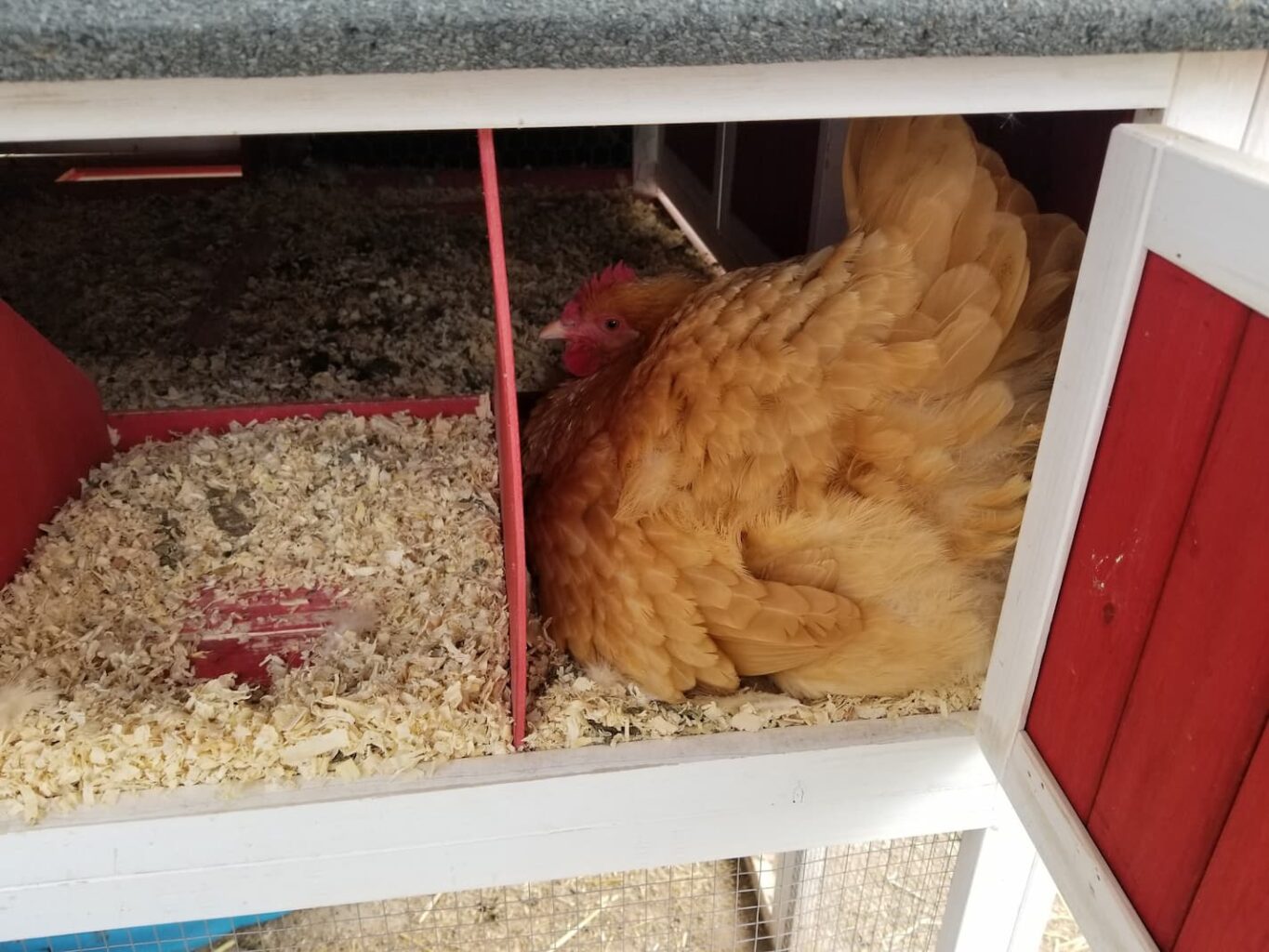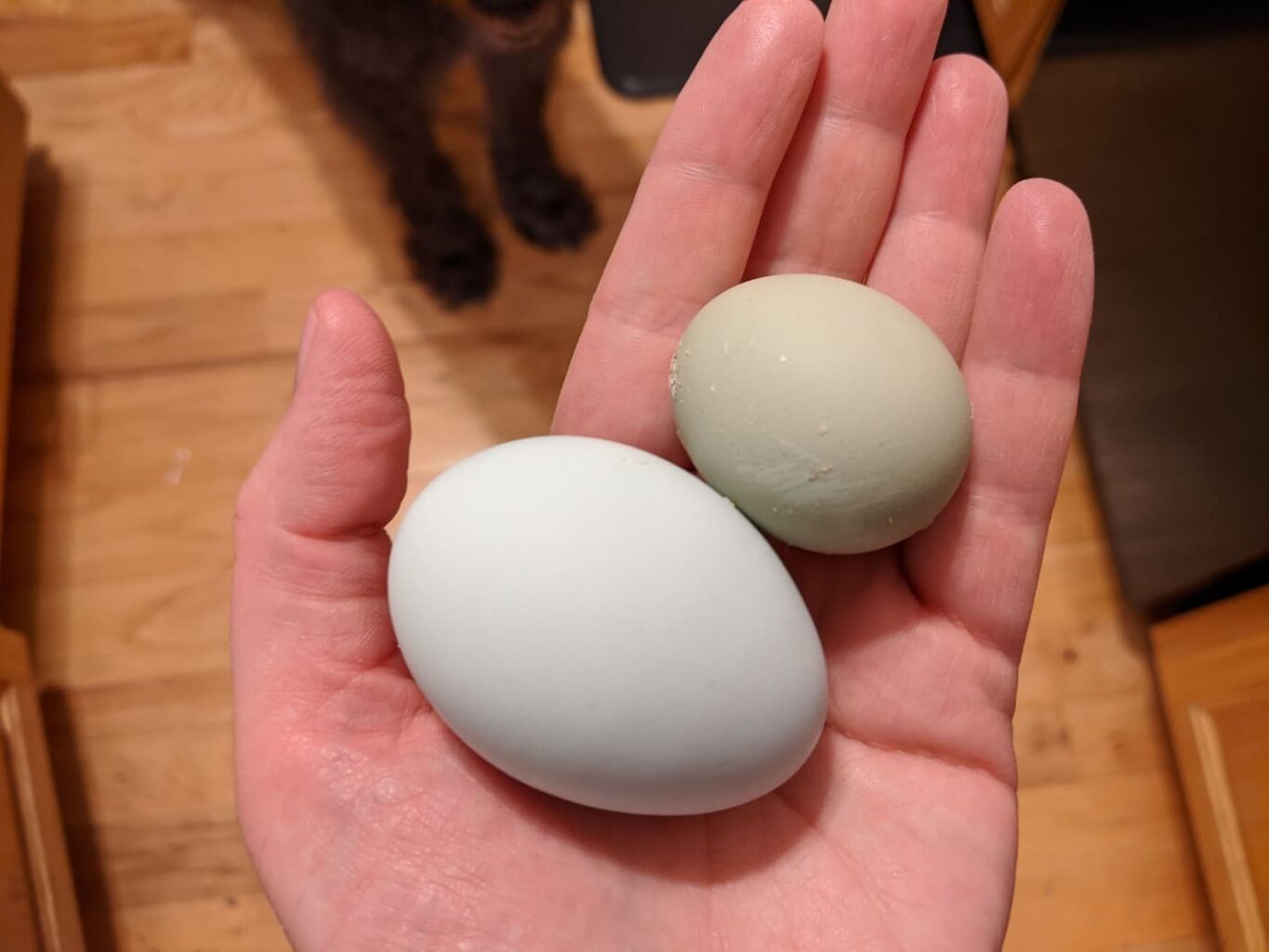Whether you’ve got chickens or you’re still researching them, it’s nice to have an idea of what to expect. And as I’ve come to find out, eggs aren’t always perfectly egg-shaped – some come with ridges. Why do some chicken eggs have ridges?
Chicken eggs develop ridges if stress or defective shell glands cause a micro-break in the eggshell during the 21+ hour long calcification process. The shell gland then reinforces the weakened area with a thicker shell, resulting in a noticeable roughness or ridge.
Even so, discovering the cause of the ridges on your chicken’s eggs can be important. So, keep reading to discover more about why your chicken’s eggs have ridges.

Why Do My Chicken Eggs Have Ridges?
In talking to my friends and searching online chicken forums, it’s commonly thought that an eggshell with a single, rough band or multiple ridges means that there’s too much calcium. However, my research into eggs with ridges shows that’s not necessarily the case. Rather, those ridges are caused by in-utero micro-breaks that have been repaired by the shell glands.
In most cases, those micro-breaks are caused by general stress, body checks, or random chance. In a small subset of even fewer cases, the micro-breaks are caused by stress that’s related to disease or deformed shell glands.
In other words, ridged eggs generally indicate stress of some kind.
Sometimes that stress is the regular kind – like when my kids open the coop doors to collect eggs and surprise a chicken who’s trying to lay (good grief, can’t a chicken get any privacy these days??). Thankfully, my chickens are well enough socialized with my cute, crazy crew that it’s not an issue for us. We haven’t had any banded chicken eggs or ridges to date.
Other times, stress could indicate an illness. Animals, and chickens especially, will hide illness and weakness as long as possible. Chickens have been known to attack a weak or injured flock mate, after all. So by the time symptoms are visibly noticeable, it’s usually too late. A ridged egg could be an early symptom of infectious bronchitis, for example.
In any case, here are the most common reasons that chickens lay eggs with ridges, based on my extensive research and talking to fellow chicken owners. Reasons are listed in the order of prevalence I’ve seen, based on my research and talking to other chicken owners.
| Reason for Eggs with Ridges | Examples and Notes |
|---|---|
| General stress | If a chicken gets stressed enough, an egg may develop a few ridges. This isn’t super common, but it does happen enough that it’s easy to find egg shape threads in homesteading forums. |
| Chronic stress | Apparently, drama-queen chickens may lay ridged eggs on a more regular basis. It’s not super common, but it happens. |
| Crowding | Overcrowded hens are more likely to get stressed and interrupted during the calcification process. Addressing overcrowding is the appropriate fix. |
| Age | New layers and older hens are more likely to lay ridged eggs. This may be an occasional or a regular thing, depending on the chicken’s age and temperament. |
| Disease | Ridged eggs are more likely to happen if a chicken is ill enough that the shell glands have been affected. Infectious bronchitis (IB) is commonly cited to cause this issue. |
| Defective or damaged shell glands | If a chicken’s shell glands are damaged or defective, then the calcification process may get disrupted more easily. Causes include illness, injury, or natural defects. |
My research and forum chatter indicates that the most common disease culprit is infectious bronchitis, which can spread to other chickens. But we’ll talk about that later on in the article.
What Do Rough Chicken Eggs (with Ridges) Look Like?
To date, my chickens haven’t laid any ridged eggs. Yes – I just knocked on the wooden door next to me! But our chickens have laid speckled eggs, eggs with weird little spots of calcification on them, and oddly-shaped eggs. Even so, oddly-shaped eggs are something I try to keep an eye out for.
Even so, by searching through online forum archives and talking to other chicken owners, I’ve seen ridges of all types.
Based on my research, the most common type of ridge is a single, thickened ring around the middle of the egg – almost like the egg was trying to wear a little egg-sized tutu.


I’ve also seen some that look like the eggshell didn’t get completely finished up at the top.
Some of these eggs are pretty spectacular, even if the eggshells are technically abnormal.
How Eggs with Ridges Happen During the Calcification Process
In my research to understand better why chicken eggs have ridges, I had to learn more about the overall egg-laying process, including calcification. So just in case, you are a backyard homesteading and/or chicken nerd like me (who likes to understand all the things), here’s what I found.
Here’s the quick version of the egg-laying process, though, because even us homesteading nerds are busy.
- The yolk (an ovum) releases from the ovary. This usually takes about 15 minutes.
- The ovum (yolk) enters the oviduct via the infundibulum and the egg white forms. This is where fertilization would occur if your chicken and a rooster mated. This step takes about 4+ hours.
- The egg transitions to the uterus and the shell forms thanks to the shell glands. The inner eggshell can take 20 or more hours to form – and that’s before the outermost layers (with the eggshell color and bloom) form. In all, this step takes 21 or more hours.
- The chicken goes and lays the egg (via the cloaca) into its favored, available nesting box.

The long eggshell-forming step is both a blessing and a potential problem.
- The problem is that it’s a long time (21+ hours!) for a chicken to be carrying an egg that could break – and bodychecks or stress can cause micro-breaks in the still-forming eggshell.
- The blessing is that the chicken’s shell glands aren’t like a machine; they can go back over a weakened area and strengthen it. Doing so will keep the egg viable – but it will cause ridges or ripples in the eggshell.
What to Do about Ridges in Chicken Eggs in Most Instances
Generally speaking (unless your chicken is ill) you don’t need to do anything about ridges in chicken eggs except continue to monitor your chickens and any eggs that are laid. In most cases, ridged or rough eggs will be a one-off kind of thing.
And the egg with the ridges laid by healthy chickens? They’re normal eggs. So enjoy them!
Now, it may take several days for your chicken’s stress levels to return to normal. So you may get a few days of eggs with ridges. But once things are back to normal, then the ridges usually stop.
In some cases, though, eggs with ridges may be a random surprise from now on from the chicken in question. That may just become the new norm – and that’s just fine.
Eggs with ridges are a fun visual surprise. They’re otherwise normal eggs.
My findings after talking to friends who’ve found chicken eggs with ridges and ripples.
But what about if your chicken is ill? What then?
When Ridges in My Chicken’s Eggs Need Treatment
Now, if it’s an illness that’s causing your chickens to lay eggs with ridges, that’s a different story. And your chicken may need treatment.
This is especially true if it’s an infectious and easily-spread respiratory disease like infectious bronchitis, which is caused by a coronavirus. Diseases like infectious bronchitis cause ridged eggs by causing both increased stress to the chicken and damaging the shell glands.
My research shows that if treated early, the damage to the shell glands may be a temporary thing. If left untreated, however, the internal damage and ridged eggs may become a permanent issue. This is especially the case if the infection happens to a younger chicken or pullet.
If you suspect illness, you’ll want to weigh the pros and cons of your options. Options may include talking to a vet, prophylactic treatment of the whole flock with appropriate treatment, or culling chickens.
Common symptoms to look for that may also indicate a respiratory illness like infectious bronchitis include: sneezing, gasping, snicking, watery discharge from the eyes or nostrils, oddly pigmented eggs, eggs with ridges, changes in egg production timing, and watery droppings that cause wet litter.
Other Possible Times that Ridges in My Chicken’s Eggs Could Indicate a Need for Treatment
There is one other time that your chicken may need treatment for laying eggs with ridges. And that’s if the stress is related to dietary issues, such as an insufficient or inappropriate balance of macro and micronutrients.
So if there’s a known deficiency or overload of a nutrient, go ahead and address that. If not, keep making sure that your flock has access to all of the nutrients they need and give things time to work themselves out.
I’ve heard conflicting reports about how various nutrients (like a crushed oyster shell) were feared to be the cause of the eggs with ridges. However, other chicken owners reported that giving their chickens access to oyster shells resolved the eggs with ridges.
I think this may be where the common misconception that eggs with ridges come from too much calcium comes from. Because many chicken owners find that giving or taking away the calcium supplements for a few days does improve things for their flock. In those cases, perhaps there was a dietary cause.
So the evidence is pretty anecdotal in both directions, hence my recommendation to just make sure you’re giving your chickens enough nutrients in general. Personally, we let our chickens forage in a small area of our backyard that we refer to as “the pasture.”
We also give them access to appropriate feed and monitor them for their appearance, behavior, and egg-laying trends. Just make sure your chickens have what they need – and things should normalize again soon.
Is One Chicken Breed More Likely to Lay Eggs with Ridges?
Based on my research, there isn’t a specific breed that seems to be more likely than others to lay eggs with ridges. I’ve read about all the different breeds and types of chickens who do (and don’t) lay eggs with ridges.
However, if your chicken is a bit of a drama-queen (no matter the breed), then anecdotal evidence in my research indicates that they are more likely to lay eggs with ridges.
But since being a drama-queen chicken isn’t breed-specific, that could still be any chicken! 😀
Resources
Learning from your own experience is essential, but learning from others is also intelligent. These are the sources used in this article and our research to be more informed as homesteaders.
- “BYC (BackYardChickens).” BYC (BackYardChickens) Public Group, www.facebook.com/groups/BackyardChickensBYC/.
- “BYC (BackYardChickens).” BYC (BackYardChickens) Public Group, www.facebook.com/groups/BackyardChickensBYC/10157762313529734/?comment_id=10158325564239734&reply_comment_id=10158325742819734¬if_id.
- Butcher, Gary D., and Richard Miles. INFECTIOUS BRONCHITIS AND ITS EFFECT ON EGG PRODUCTION AND EGG QUALITY. www.afn.org/~poultry/flkman3.htm.
- Sumi. “Common Egg Quality Problems.” BackYard Chickens – Learn How to Raise Chickens, 3 May 2016, www.backyardchickens.com/articles/common-egg-quality-problems.65923/.